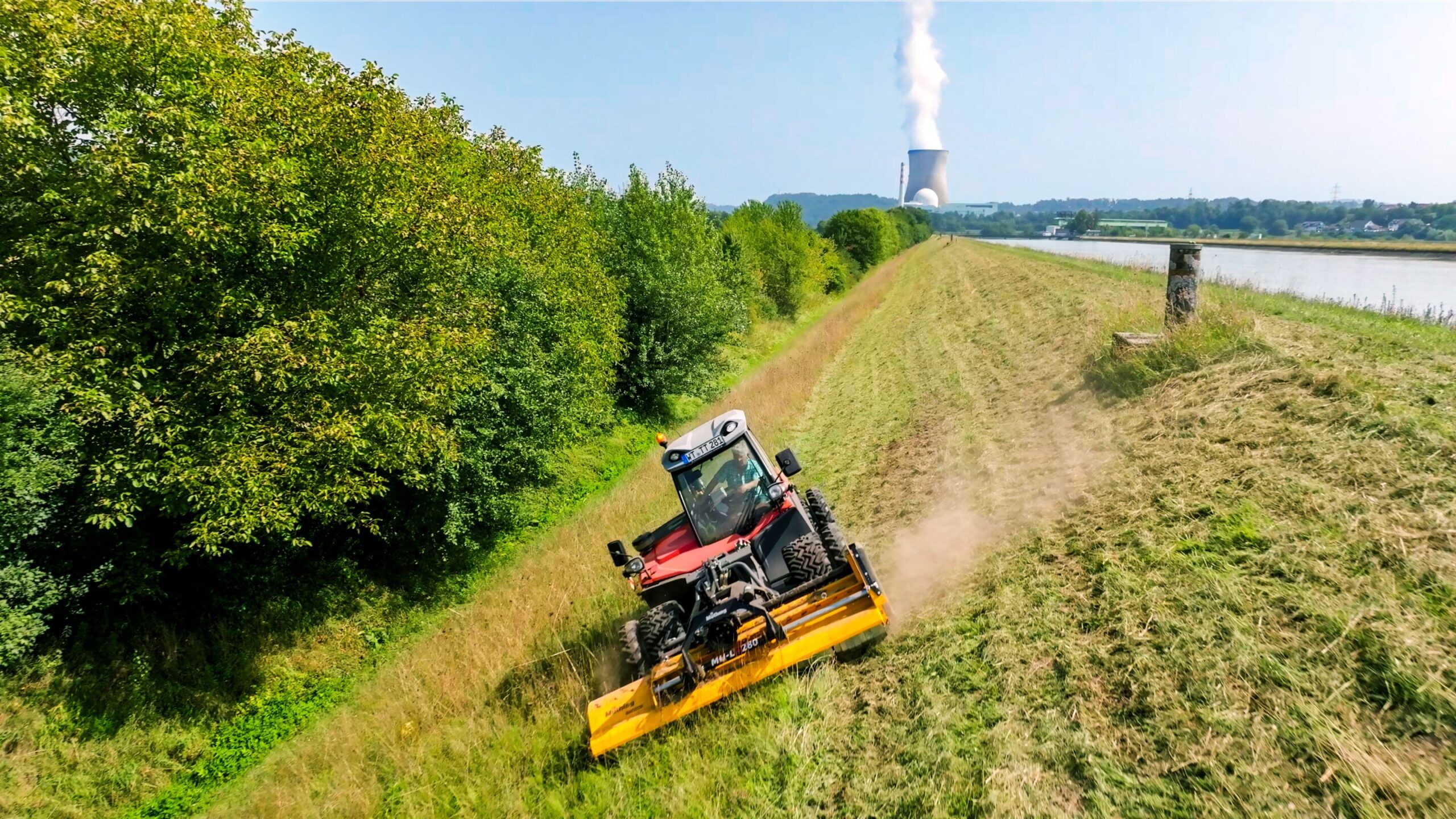Tech
New drivetrain technology for off-road vehicles moves safely in difficult terrain

Wet meadows, steep slopes, and loose ground often present a challenge to agricultural vehicles. A new drive system that gets off-road vehicles safely through difficult terrain has been developed by researchers of Karlsruhe Institute of Technology (KIT) together with a partner from industry. It replaces conventional differential gears with an independent gearbox on each wheel. This way, it is possible to cope with terrain that was impassable before.
Vehicles such as tractors or slope mowers have been equipped with conventional differential gears until now. They ensure that the wheels of an axle rotate at different speeds when cornering—this operating condition is called open differential. The drawback is that if one wheel loses grip, it starts slipping and the axis’s second wheel stalls. This results in reduced traction.
A locked differential, on the other hand, ensures that both wheels of an axle are linked to each other and that they rotate synchronously. Thus, the vehicle can also manage rough terrain, for example when driving on meadows, snow, or muddy ground. However, cornering is not possible.
Two principles, one system—advantages in off-road terrain
The new drive system compensates for the disadvantages of both principles: It improves wheel grip and at the same time enables exact speed compensation when cornering because it has a gearbox with individual speed control on each wheel.
“The system automatically adjusts the wheel speeds to the driving situation, so that it precisely distributes the complete mechanical force from the powertrain to the wheels while controlling individual wheel speeds at the same time,” says Stefan Herr, leader of the Drive Technology research group at KIT’s Institute Mobile Machines.
This way, all wheels rotate with optimum speed at maximum force transmission—the vehicle is able to move even in difficult situations.
“A tractor equipped with the Line Traction System provides more performance and better safety by getting the power to the ground—even on steep slopes or uneven ground,” says Herr.
“Our test vehicle moves on where others stop. Farmland that have been unusable so far or had to be mowed by hand can now be worked by machines.” Possible uses include mowing steep slopes along motorways or meadows in mountainous regions.
Another great advantage of the system: The conventional drivetrain with a central drive unit is preserved. This makes for a compact and economic overall system without an increase in weight. Either a combustion engine or an electric motor can be used as the primary drive.
“The system is also suitable for emission-free drives and thus future-proof,” explains Herr.
The technology is the result of a cooperation with Müller Landmaschinen GmbH, the company that invented the system. In a series of projects, the partners developed and studied the system from the initial idea to the pre-production series.
“Our research is closely linked to practice—we bring knowledge to the road or field,” says Herr. “In addition, students and doctoral researchers have been involved in the research work right from the start. This is an opportunity for them to provide input to ongoing projects and contribute to innovations early on.”
Citation:
New drivetrain technology for off-road vehicles moves safely in difficult terrain (2025, October 29)
retrieved 29 October 2025
from https://techxplore.com/news/2025-10-drivetrain-technology-road-vehicles-safely.html
This document is subject to copyright. Apart from any fair dealing for the purpose of private study or research, no
part may be reproduced without the written permission. The content is provided for information purposes only.
Tech
The Best Cozy Earth Pajamas Deal We’ve Seen All Year

I love having a whimsical, comfortable wardrobe, and that doesn’t apply just to daytime clothes. My pajama collection is quite extensive, with the added requirement that each pair be both cooling and extra soft. I’m someone who overheats easily in her sleep, and with sensitive skin, it’s not a winning combination.
I’ve been growing my Cozy Earth pajama collection for years, usually getting a new set during Black Friday. Obviously, that shopping event has come and gone, but this sale gives you one more chance. And, believe it or not, it’s even better than what Cozy Earth ran sale-wise for its pajamas during Cyber Week.
Tech
We Just Found Out Taylor Swift Sleeps on a Coop Pillow—They’re Having a Flash Sale to Celebrate

While I’m a mattress and sleep product expert, thanks to years of hands-on experience, I’m also aware that my opinion is not the end-all, be-all for everyone. However, when a megastar is also a fan of a product you’ve reviewed, it’s a good confirmation that you’re on the right track.
Taylor Swift, as it would turn out, is also a fan of Coop Sleep Goods—which we can confirm based on this December 10 Late Show With Stephen Colbert appearance.
Coop’s got some of our favorite pillows, particularly the Original Adjustable pillow. It comes in three shapes: the Crescent, the Cut Out, and the Classic, which is a traditional rectangular shape. I love (and regularly sleep on) the Crescent, which has a gentle curve on the bottom to allow for movement while maintaining head and neck support.
Tech
Nvidia Becomes a Major Model Maker With Nemotron 3

Nvidia has made a fortune supplying chips to companies working on artificial intelligence, but today the chipmaker took a step toward becoming a more serious model maker itself by releasing a series of cutting-edge open models, along with data and tools to help engineers use them.
The move, which comes at a moment when AI companies like OpenAI, Google, and Anthropic are developing increasingly capable chips of their own, could be a hedge against these firms veering away from Nvidia’s technology over time.
Open models are already a crucial part of the AI ecosystem with many researchers and startups using them to experiment, prototype, and build. While OpenAI and Google offer small open models, they do not update them as frequently as their rivals in China. For this reason and others, open models from Chinese companies are currently much more popular, according to data from Hugging Face, a hosting platform for open source projects.
Nvidia’s new Nemotron 3 models are among the best that can be downloaded, modified, and run on one’s own hardware, according to benchmark scores shared by the company ahead of release.
“Open innovation is the foundation of AI progress,” CEO Jensen Huang said in a statement ahead of the news. “With Nemotron, we’re transforming advanced AI into an open platform that gives developers the transparency and efficiency they need to build agentic systems at scale.”
Nvidia is taking a more fully transparent approach than many of its US rivals by releasing the data used to train Nemotron—a fact that should help engineers modify the models more easily. The company is also releasing tools to help with customization and fine-tuning. This includes a new hybrid latent mixture-of-experts model architecture, which Nvidia says is especially good for building AI agents that can take actions on computers or the web. The company is also launching libraries that allow users to train agents to do things using reinforcement learning, which involves giving models simulated rewards and punishments.
Nemotron 3 models come in three sizes: Nano, which has 30 billion parameters; Super, which has 100 billion; and Ultra, which has 500 billion. A model’s parameters loosely correspond to how capable it is as well as how unwieldy it is to run. The largest models are so cumbersome that they need to run on racks of expensive hardware.
Model Foundations
Kari Ann Briski, vice president of generative AI software for enterprise at Nvidia, said open models are important to AI builders for three reasons: Builders increasingly need to customize models for particular tasks; it often helps to hand queries off to different models; and it is easier to squeeze more intelligent responses from these models after training by having them perform a kind of simulated reasoning. “We believe open source is the foundation for AI innovation, continuing to accelerate the global economy,” Briski said.
The social media giant Meta released the first advanced open models under the name Llama in February 2023. As competition has intensified, however, Meta has signaled that its future releases might not be open source.
The move is part of a larger trend in the AI industry. Over the past year, US firms have moved away from openness, becoming more secretive about their research and more reluctant to tip off their rivals about their latest engineering tricks.
-

 Politics1 week ago
Politics1 week agoThailand launches air strikes against Cambodian military: army
-

 Fashion1 week ago
Fashion1 week agoGermany’s LuxExperience appoints Francis Belin as new CEO of Mytheresa
-

 Politics1 week ago
Politics1 week agoZelenskiy says Ukraine’s peace talks with US constructive but not easy
-

 Politics5 days ago
Politics5 days agoTrump launches gold card programme for expedited visas with a $1m price tag
-

 Tech6 days ago
Tech6 days agoJennifer Lewis ScD ’91: “Can we make tissues that are made from you, for you?”
-

 Politics1 week ago
Politics1 week ago17 found dead in migrant vessel off Crete: coastguard
-

 Business5 days ago
Business5 days agoRivian turns to AI, autonomy to woo investors as EV sales stall
-

 Entertainment1 week ago
Entertainment1 week agoToo big to fail? IndiGo crisis exposes risks in Indian aviation


















